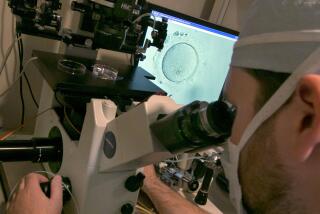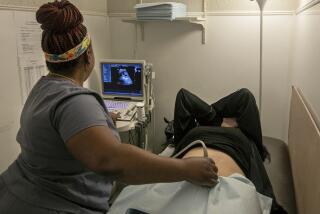Procedures Buy Mothers Time : Parents Offered New, Earlier Methods of Prenatal Diagnosis
When Irvine computer operator Linda Nielsen learned that she was pregnant with triplets, her excitement was mixed with fear.
Nielsen carries a chromosomal defect that could lead to a defective child, so she and her husband, Jack, wanted to know as soon as possible if the babies would be normal.
Three years ago--the last time she was pregnant--Nielsen had to wait until 16 weeks’ gestation before she could undergo amniocentesis. But this time, only 9 weeks into her pregnancy, Nielsen underwent an experimental procedure in which her doctor took a small sample of tissue from the membrane surrounding each of the three fetuses. And 2 weeks later, Nielsen was overjoyed to learn that all three babies were OK.
“We wanted to know what to be prepared for,” Nielsen said. “The fact that it was done so early on eased a lot of apprehension.”
Nielsen’s doctor, Arthur I. Goldstein, is one of several Orange County obstetricians offering patients new and earlier methods of prenatal diagnosis.
Working out of St. Joseph Hospital in Orange, Goldstein and collaborator Dr. Donald E. Murphy are among 30 researchers in the country approved by the U.S. Food and Drug Administration to investigate a procedure called chorionic villus sampling--a method that may someday replace amniocentesis in identifying Down’s syndrome and other genetic defects.
Also, at UCI Medical Center, pregnant women can now opt for early amniocentesis--at 11 1/2 weeks instead of the traditional 16.
The aim of both techniques is the same--letting a woman know quickly if her baby is healthy. And if the answer is no, she can terminate a pregnancy sooner, perhaps in the first trimester, if she so desires.
An abortion after amniocentesis, typically with a 19-week-old fetus, is “a medical nightmare. It’s tremendously difficult . . . not only in medical risk but emotional trauma,” Goldstein said.
Added Murphy: “It’s a big hassle. You start to feel the baby moving. There’s bonding. It’s much less emotional and more private if it’s done earlier.”
Fetal Cells Analyzed
In amniocentesis, the doctor inserts a needle into the woman’s abdomen, removing a small amount of the amniotic fluid that bathes the fetus. Fetal cells that have drifted into the fluid are then analyzed for chromosome abnormalities.
Medical experts have believed that they needed to wait until the 16th week of pregnancy to perform this procedure so that enough amniotic fluid was produced to allow some to be removed safely for culture.
But UCI’s Dr. Manuel Porto, who since December has been performing the procedure as early as 11 1/2 weeks, called the 16-week limit “folklore.” Now, laboratory advances have made it easier to grow cells from a very small amount of amniotic fluid, he said, and “doing the procedure earlier doesn’t hamper anything.”
Porto, director of perinatal ultrasound at the medical center, so far has performed early amniocentesis on 30 patients without complications and has found one fetus with congenital defects.
But Goldstein, who has also performed early amniocentesis, believes that technique still doesn’t offer results soon enough.
Dangerous Area
“The problem is, if you do it at 12, 13, 14 weeks, by the time you get the results back you haven’t accomplished that much. You’re still in the dangerous area when it comes to pregnancy termination,” he said.
By contrast, chorionic villus sampling--or CVS, as it is known--can be performed at 9 weeks, with preliminary results available the next day and final results available 7 to 10 days later.
In that technique, Goldstein studies the black-and-white image of the tiny fetus on an ultrasound monitor. Watching the monitor, he then guides a slim catheter into the cervix and into the uterus to extract pieces of chorionic villus tissue--the tissue that will eventually become the placenta. The procedure, which can also be performed through the abdomen using a needle, usually takes about 5 minutes, he said.
The lab analysis from CVS offers chromosomal information about the fetus but, unlike amniocentesis, does not reveal defects of the spinal cord. So patients who have CVS need to return for a blood test at 16 weeks, as well as another ultrasound, to examine the structure of the maturing fetus, Goldstein said.
The cost for CVS is higher than for amniocentesis--$1,700 versus $1,000--but Goldstein predicted that when the CVS is approved for general use, perhaps in a year, the cost will go down.
U.S. research into CVS was 3 years old when Goldstein and Murphy joined the investigation in 1986. Concerned that their technique might lead to a miscarriage, they performed the first 50 procedures on women who were already planning to terminate their pregnancies, Goldstein said.
Then, last July, they began offering it to patients with ongoing pregnancies. So far they have performed CVS on 21 patients and had no miscarriages from the procedure, although they did find serious chromosome problems in one fetus that led one patient to terminate her pregnancy.
Goldstein argues that the risk of miscarriage from CVS is not significantly greater than the risk from a traditional amniocentesis. He cited a Canadian study published in the January issue of Lancet that showed only 0.6% more miscarriages with CVS than with amniocentesis.
But UCI’s Porto expressed concern about CVS miscarriage rates. Other studies had reported miscarriages of up to 4.9% from CVS, he noted, adding, “Patients who (are at risk for) abortion may not want to do CVS.”
Interested in CVS
Still, Porto conceded, UCI is interested in performing CVS too, perhaps by next fall. Because of concern about uterine infections, Porto said he would probably perform CVS through the abdomen where “the likelihood of infection would be virtually nonexistent.
Still, he said, “when all the smoke clears, there may be virtually no difference between early amniocentesis, CVS and later amniocentesis. It may be for most patients a matter of choice, of their anxiety level, whether to do one or the other.”
For some mothers-to-be, however, that anxiety level is very high.
Consider 31-year-old Ann Kim of Mission Viejo. When she learned that she was pregnant last year, she knew also that her risk of bearing a retarded child was high. Her first son, now 1, has Down’s syndrome, and she and her husband knew that there was a higher-than-usual risk that their second baby might be retarded too.
Her obstetrician suggested amniocentesis, but that didn’t satisfy Kim.
“I didn’t want to have an amnio where you have to wait half the pregnancy,” she said.
Just Wanted to Know
Kim said that she never planned to terminate the pregnancy but that she and her husband “just wanted to know ahead of time. We just wanted to know.”
So last July, Kim became St. Joseph’s first patient with an ongoing pregnancy to undergo CVS. And 10 days later, she learned that her baby was normal.
Six-pound, 13-ounce Matthew was born Jan. 27, and, as the test had indicated, he was fine.
But Kim said she was relieved to learn early in her pregnancy that she was having a normal baby. “I don’t agree with abortion,” she said. “But it was just nice knowing that you were having what you wanted: a healthy child.”
TECHNIQUES OF PRENATAL DIAGNOSIS Amniocentesis: Now 20 years old in the United States, it is the commonly accepted technique of prenatal diagnosis. Performed at 16 weeks of gestation and costing about $1,000, it reveals chromosomal and spinal cord defects in fetus.
Early Amniocentesis: Considered experimental, it is performed at 11 1/2 weeks of gestation and costs about $1,000. It reveals chromosomal and spinal cord defects in fetus.
Chorionic Villus Sampling: Under study in United States since 1983, it is considered experimental. Performed at 9 to 11 weeks of gestation and costing about $1,700, it reveals chromosomal defects but not spinal cord problems in the fetus.






